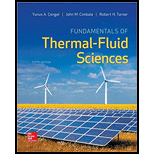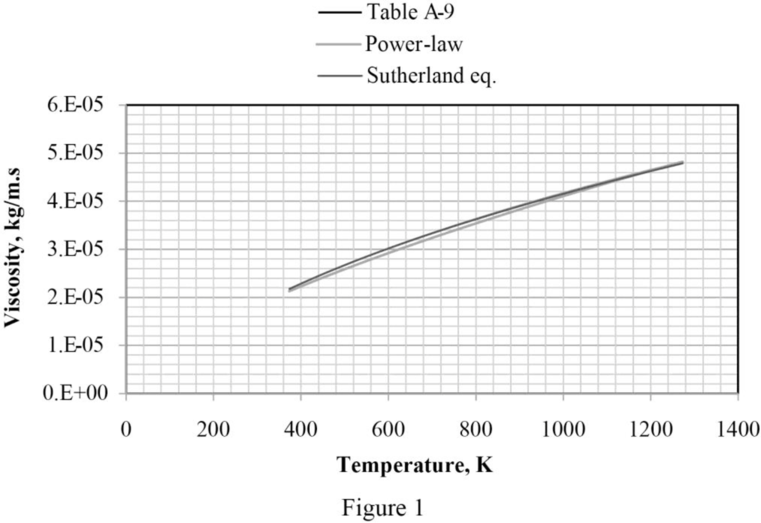
Fundamentals of Thermal-Fluid Sciences
5th Edition
ISBN: 9780078027680
Author: Yunus A. Cengel Dr., Robert H. Turner, John M. Cimbala
Publisher: McGraw-Hill Education
expand_more
expand_more
format_list_bulleted
Question
Chapter 10, Problem 28P
To determine
Examine the variation in the air viscosity and plot it in a graph.
Expert Solution & Answer
Explanation of Solution
Determine the following properties for the corresponding temperatures from Table A-22.
| Table A-9 | Power law | Sutherland | PL-Error % | Suth Error % | |
| 373 | 2.41 | 0.38 | |||
| 393 | 2.66 | 0.33 | |||
| 413 | 2.86 | 0.30 | |||
| 433 | 2.86 | 0.10 | |||
| 453 | 3.25 | 0.36 | |||
| 473 | 3.25 | 0.24 | |||
| 523 | 3.41 | 0.25 | |||
| 573 | 3.44 | 0.26 | |||
| 623 | 3.30 | 0.31 | |||
| 673 | 3.30 | 0.36 | |||
| 723 | 3.12 | 0.38 | |||
| 773 | 2.94 | 0.45 | |||
| 873 | 2.50 | 0.56 | |||
| 973 | 1.95 | 0.64 | |||
| 1073 | 1.37 | 0.73 | |||
| 1173 | 0.76 | 0.78 | |||
| 1273 | 0.11 | 0.81 |
Plot the accuracy of both models as in Figure (1).

Want to see more full solutions like this?
Subscribe now to access step-by-step solutions to millions of textbook problems written by subject matter experts!
Students have asked these similar questions
PROBLEM 3.23
3.23 Under normal operating condi-
tions a motor exerts a torque of
magnitude TF at F. The shafts
are made of a steel for which
the allowable shearing stress is
82 MPa and have diameters of
dCDE=24 mm and dFGH = 20
mm. Knowing that rp = 165
mm and rg114 mm, deter-
mine the largest torque TF
which may be exerted at F.
TF
F
rG-
rp
B
CH
TE
E
1. (16%) (a) If a ductile material fails under pure torsion, please explain the failure
mode and describe the observed plane of failure.
(b) Suppose a prismatic beam is subjected to equal and opposite couples as shown
in Fig. 1. Please sketch the deformation and the stress distribution of the cross
section.
M
M
Fig. 1
(c) Describe the definition of the neutral axis.
(d) Describe the definition of the modular ratio.
using the theorem of three moments, find all the moments, I only need concise calculations with minimal explanations. The correct answers are provided at the bottom
Chapter 10 Solutions
Fundamentals of Thermal-Fluid Sciences
Ch. 10 - Prob. 1PCh. 10 - Define incompressible flow and incompressible...Ch. 10 - Define internal, external, and open-channel...Ch. 10 - What is the no-slip condition? What causes it?
Ch. 10 - What is forced flow? How does it differ from...Ch. 10 - What is a boundary layer? What causes a boundary...Ch. 10 - What is cavitation? What causes it?
Ch. 10 - Does water boil at higher temperatures at higher...Ch. 10 - If the pressure of a substance is increased during...Ch. 10 - What is vapor pressure? How is it related to...
Ch. 10 - The analysis of a propeller that operates in water...Ch. 10 - A pump is used to transport water to a higher...Ch. 10 - In a piping system, the water temperature remains...Ch. 10 - The analysis of a propeller that operates in water...Ch. 10 - Prob. 15PCh. 10 - Prob. 16PCh. 10 - Prob. 17PCh. 10 - How does the dynamic viscosity of (a) liquids and...Ch. 10 - Consider two identical small glass balls dropped...Ch. 10 - The viscosity of a fluid is to be measured by a...Ch. 10 - Prob. 21PCh. 10 - Consider the flow of a fluid with viscosity μ...Ch. 10 - A thin 30-cm × 30-cm flat plate is pulled at 3 m/s...Ch. 10 - A rotating viscometer consists of two concentric...Ch. 10 - Prob. 25PCh. 10 - The dynamic viscosities of carbon dioxide at 50°C...Ch. 10 - Prob. 28PCh. 10 - For flow over a plate, the variation of velocity...Ch. 10 - In regions far from the entrance, fluid flow...Ch. 10 - Prob. 31PCh. 10 - Prob. 32PCh. 10 - Prob. 33PCh. 10 - A large plate is pulled at a constant speed of U =...Ch. 10 - Prob. 35PCh. 10 - A small-diameter tube is inserted into a liquid...Ch. 10 - Prob. 37PCh. 10 - Prob. 38PCh. 10 - Is the capillary rise greater in small-or...Ch. 10 - Prob. 40PCh. 10 - Prob. 41PCh. 10 - A 1.2-mm-diameter tube is inserted into an unknown...Ch. 10 - Determine the gage pressure inside a soap bubble...Ch. 10 - A 0.03-in-diameter glass tube is inserted into...Ch. 10 - Prob. 45PCh. 10 - Prob. 46PCh. 10 - A capillary tube is immersed vertically in a water...Ch. 10 - Prob. 48PCh. 10 - Prob. 49PCh. 10 - Prob. 50RQCh. 10 - Consider a 55-cm-long journal bearing that is...Ch. 10 - Prob. 52RQCh. 10 - The pressure on the suction side of pumps is...Ch. 10 - Consider laminar flow of a Newtonian fluid of...Ch. 10 - Prob. 56RQCh. 10 - Prob. 57RQCh. 10 - Some rocks or bricks contain small air pockets in...
Knowledge Booster
Learn more about
Need a deep-dive on the concept behind this application? Look no further. Learn more about this topic, mechanical-engineering and related others by exploring similar questions and additional content below.Similar questions
- PROBLEM 3.46 The solid cylindrical rod BC of length L = 600 mm is attached to the rigid lever AB of length a = 380 mm and to the support at C. When a 500 N force P is applied at A, design specifications require that the displacement of A not exceed 25 mm when a 500 N force P is applied at A For the material indicated determine the required diameter of the rod. Aluminium: Tall = 65 MPa, G = 27 GPa. Aarrow_forwardFind the equivalent mass of the rocker arm assembly with respect to the x coordinate. k₁ mi m2 k₁arrow_forward2. Figure below shows a U-tube manometer open at both ends and containing a column of liquid mercury of length l and specific weight y. Considering a small displacement x of the manometer meniscus from its equilibrium position (or datum), determine the equivalent spring constant associated with the restoring force. Datum Area, Aarrow_forward
- 1. The consequences of a head-on collision of two automobiles can be studied by considering the impact of the automobile on a barrier, as shown in figure below. Construct a mathematical model (i.e., draw the diagram) by considering the masses of the automobile body, engine, transmission, and suspension and the elasticity of the bumpers, radiator, sheet metal body, driveline, and engine mounts.arrow_forward3.) 15.40 – Collar B moves up at constant velocity vB = 1.5 m/s. Rod AB has length = 1.2 m. The incline is at angle = 25°. Compute an expression for the angular velocity of rod AB, ė and the velocity of end A of the rod (✓✓) as a function of v₂,1,0,0. Then compute numerical answers for ȧ & y_ with 0 = 50°.arrow_forward2.) 15.12 The assembly shown consists of the straight rod ABC which passes through and is welded to the grectangular plate DEFH. The assembly rotates about the axis AC with a constant angular velocity of 9 rad/s. Knowing that the motion when viewed from C is counterclockwise, determine the velocity and acceleration of corner F.arrow_forward
arrow_back_ios
SEE MORE QUESTIONS
arrow_forward_ios
Recommended textbooks for you
 Elements Of ElectromagneticsMechanical EngineeringISBN:9780190698614Author:Sadiku, Matthew N. O.Publisher:Oxford University Press
Elements Of ElectromagneticsMechanical EngineeringISBN:9780190698614Author:Sadiku, Matthew N. O.Publisher:Oxford University Press Mechanics of Materials (10th Edition)Mechanical EngineeringISBN:9780134319650Author:Russell C. HibbelerPublisher:PEARSON
Mechanics of Materials (10th Edition)Mechanical EngineeringISBN:9780134319650Author:Russell C. HibbelerPublisher:PEARSON Thermodynamics: An Engineering ApproachMechanical EngineeringISBN:9781259822674Author:Yunus A. Cengel Dr., Michael A. BolesPublisher:McGraw-Hill Education
Thermodynamics: An Engineering ApproachMechanical EngineeringISBN:9781259822674Author:Yunus A. Cengel Dr., Michael A. BolesPublisher:McGraw-Hill Education Control Systems EngineeringMechanical EngineeringISBN:9781118170519Author:Norman S. NisePublisher:WILEY
Control Systems EngineeringMechanical EngineeringISBN:9781118170519Author:Norman S. NisePublisher:WILEY Mechanics of Materials (MindTap Course List)Mechanical EngineeringISBN:9781337093347Author:Barry J. Goodno, James M. GerePublisher:Cengage Learning
Mechanics of Materials (MindTap Course List)Mechanical EngineeringISBN:9781337093347Author:Barry J. Goodno, James M. GerePublisher:Cengage Learning Engineering Mechanics: StaticsMechanical EngineeringISBN:9781118807330Author:James L. Meriam, L. G. Kraige, J. N. BoltonPublisher:WILEY
Engineering Mechanics: StaticsMechanical EngineeringISBN:9781118807330Author:James L. Meriam, L. G. Kraige, J. N. BoltonPublisher:WILEY

Elements Of Electromagnetics
Mechanical Engineering
ISBN:9780190698614
Author:Sadiku, Matthew N. O.
Publisher:Oxford University Press

Mechanics of Materials (10th Edition)
Mechanical Engineering
ISBN:9780134319650
Author:Russell C. Hibbeler
Publisher:PEARSON

Thermodynamics: An Engineering Approach
Mechanical Engineering
ISBN:9781259822674
Author:Yunus A. Cengel Dr., Michael A. Boles
Publisher:McGraw-Hill Education

Control Systems Engineering
Mechanical Engineering
ISBN:9781118170519
Author:Norman S. Nise
Publisher:WILEY

Mechanics of Materials (MindTap Course List)
Mechanical Engineering
ISBN:9781337093347
Author:Barry J. Goodno, James M. Gere
Publisher:Cengage Learning

Engineering Mechanics: Statics
Mechanical Engineering
ISBN:9781118807330
Author:James L. Meriam, L. G. Kraige, J. N. Bolton
Publisher:WILEY
Mod-01 Lec-16 Basics of Instrumentation; Author: nptelhrd;https://www.youtube.com/watch?v=qbKnW42ZM5c;License: Standard YouTube License, CC-BY